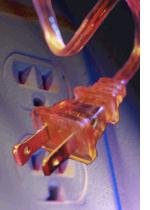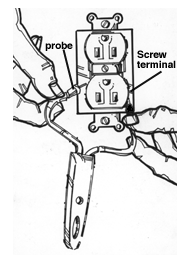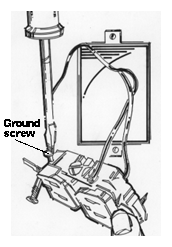|
Website: http://www.truevalue.com
Level of difficulty: Beginner


When your wall outlet no longer works, your first move may be to call an electrician. But replacing an outlet is easy and SAFE if you follow the steps below.
Also, you might want to change a standard outlet to the ground fault circuit interrupter (GFCI) type that's found in kitchens and bathrooms and is much
safer for your family.
Safety Tip: The ground fault circuit interrupter (GFCI) protects the user by shutting off the power when water splashes up onto the outlet. It also protects
against small power surges. Ideally, test the GFCI once a month. Press the test button and wait for the reset button to pop out.
Tools and Materials you need:
- Circuit tester
- Screwdriver
- Masking tape
- Replacement wall outlet
 Tip: Tip:
Make sure the outlet you use to replace the old one has the same voltage, amp and wire gauge readings. Look on the back of the old outlet.

 1. Turn Off Power and Test
1. Turn Off Power and Test
Before you begin this project it is important, as in all electrical work, to turn off the power to the outlet. Turn the circuit for that area of
the house to the off position or unscrew the fuse. Once this is done it is important to test to make absolutely sure that no power is traveling
through the outlet. Do this by unscrewing and removing the cover plate of the outlet and touch the probes of the tester to the two top screws that
are located on the sides of the outlet. Repeat this process and test with the bottom screws. If the tester doesn't light up, it is safe to proceed.
|
2. Find Amp, Voltage, and Wire Gauge Readings
Remove the mounting screws that attach the outlet to the wall and pull the outlet out. Check the back of the outlet to get the amp, voltage and
wire gauge readings so that you can get your replacement. |
 Tip:
Tip:
Put back the old outlet and cover plate before you go get the replacement. That way you don't have exposed wires lying around. When you come back,
check to make sure that the circuit breaker is still off for that area and test with the circuit tester again. Proceed to Step 3. |
3. Remove Old Outlet
Remove the wires from the old outlet, making sure to remember the arrangement. The wires can be removed by unscrewing them or by pushing the release
button, depending on the type of outlet. |
 Tip:
Tip:
Use masking tape to mark on the new outlet where the wires go. |
 4. Replace with New Outlet
4. Replace with New Outlet
Attach the wires to the new outlet in the same arrangement that they were on the old outlet. (See figure for one example of a typical arrangement
of wires.) Once this is done you can replace the outlet to its position on the wall and attach it. Replace the cover plate and turn the power back
on. |
Note: This article was submitted by a second party and the contents are subject to our disclaimer.
|


